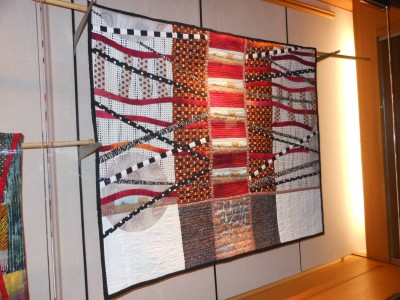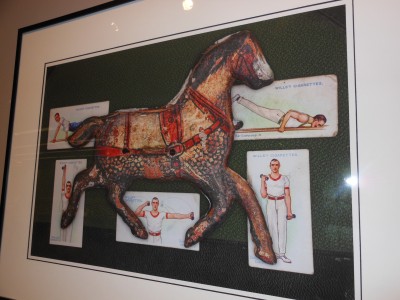 In 2008, Catherine Whall Smith was working on a quilt about the presidents of the United States. She thought Hillary Clinton would get the Democratic nomination and then win the presidency. Then Clinton conceded. So Smith excluded Clinton and just changed the name of the quilt to “Where’s Hillary?”
In 2008, Catherine Whall Smith was working on a quilt about the presidents of the United States. She thought Hillary Clinton would get the Democratic nomination and then win the presidency. Then Clinton conceded. So Smith excluded Clinton and just changed the name of the quilt to “Where’s Hillary?”
That wasn’t the only time Smith changed the theme of a quilt in the middle of creating it. In 2009, she was working on a yellow quilt, and she was diagnosed with Lyme Disease. She was given three kinds of medicine. One was yellow. “It seemed appropriate,” she says. She changed the theme of her quilt to “Lyme Disease Babiosa Strain.”
“When I’m planning a quilt, I might pick out a palette, but I interpret it as I work with it,” Smith says. “The quilt itself tells me where it’s going.”
Smith’s quilts are the focus of a new exhibit at the University of Connecticut, “Line Dances.” It is at the Homer Babbidge Library and the Dodd Center on campus in Storrs.
Smith, who retired in 2008 from her position at UConn’s Neag School of Education, is inspired by a lot of things: her family, her friends, hay bales she sees in the fields while commuting from Chaplin to Storrs.
She has a lot of fun with those hay bales. “I just noticed them one day, in the field, with the white plastic over them. They fascinated me. They looked like marshmallows,” she says. Her quilts show variations on the theme of white-covered hay bales. A single bale is “Alone But Not Lonely.” In a row, they’re “Pearly Whites.” In the sunshine, they’re “Hay in Heat.” In the enticing autumnal colors, they’re “Rolling in the Hay.”
Not all of Smith’s quilts are amusing. One titled “Pain” was made after her sister died. The quilt features lines intersecting each other in almost a grid pattern. “Pain goes in and out and through you until you’re rid of it,” she says. “Drilling for Oil,” from 2008, is accented by a penguin pattern, to show the creatures whose lives are endangered by oil drilling.
But really, every quilt she makes is about one thing: patterns, colors, lines, especially the wavy lines that are her trademark. “These lines are the voice in my quilts,” she writes.
 ‘Natura Morta’
‘Natura Morta’
Daniel Mosher Long got his MA at the Neag School, but that’s where his and Smith’s commonalities end.
As an artist, Long gathers together strange accumulations of objects — a wrench, lace and a robin’s egg; dead bugs and pretty china; bird claws, flower petals and mah jonng tiles; a caterpillar, a light bulb and a cut-glass plate — arranges them artfully and then photographs them, giving them all an antique look that emphasizes their strangeness.
His work is the focus of another show in the Homer Babbidge Library at UConn, “Natural Morta.”
“Many but not all of the objects in my photos are family mementos. Things passed down through the generations. Other things I have found in and around Mansfield (i.e. animal bones) or purchased during my travels,” he says. “Most of the birds, snakes and rodents (mice, voles, shrews) were supplied by my two cats.
“I had a collection of oddities long before I started photographing them,” he says.
Even though his objects are odd and his arrangements are often disturbing, Long says he does not intend for the images to be sinister.
“Many of the objects I use in the compositions are not suitable for Hallmark cards. And I have an interest in how objects are associated with magic and voodoo. But I do not go out of my way to make images that are scary or disturbing,” he says.
Long, a resident of Mansfield who teaches photography at Manchester Community College, says he likes it when the objects create a narrative. But that’s not necessary.
“I also like my images to be open to interpretation. I like ambiguity. I don’t want the work to be too literal,” he says. “I think the work is more interactive, more engaging, when it is less straightforward.”
LINE DANCES: QUILTS BY CATHERINE WHALL SMITH and NATURA MORTA: CABINET OF CURIOSITIES will be at the Homer Babbidge Library, 369 Fairfield Way, and the Thomas J. Dodd Research Center, 405 Babbidge Road, both at the University of Connecticut in Storrs, until Friday, Oct. 19. Opening receptions for all three exhibits will be on Sunday, July 29, from 2 to 4 p.m. Details: http://lib.uconn.edu/about/exhibits.
Copyright © 2012, The Hartford Courant
To see more pictures of the exhibits, visit here.
 Facebook
Facebook
 Twitter
Twitter
 LinkedIn
LinkedIn
